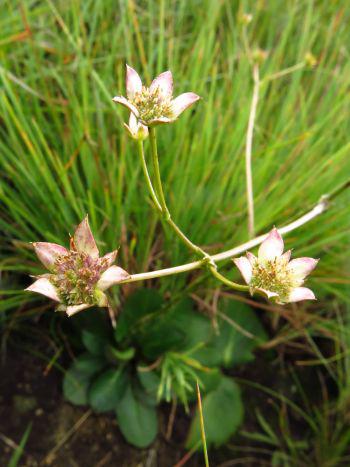Alepidea natalensis
Alepidea natalensis J.M.Wood & M.S.Evans
Family: Apiaceae
Common names: Natal star flower
Introduction
A dainty perennial with starry white flowers on long stalks, from the grasslands of the Drakensberg.

Description
Description
Alepidea natalensis is an herbaceous perennial, 200–600 mm tall, with small leathery leaves and thin flower stalks, with small, white, star-shaped flowers at the tips. The stems are bare in the upper parts. The leaves are in a basal rosette narrowing to a stalk 10–20 mm long. They are dark green and leathery; the margins are entire or toothed and have bristles.

The star-shaped flowers are flowerheads, made up of many small flowers surrounded by petal-like bracts. The flowerheads are ± 15 mm in diameter, with 5 equal, triangular bracts, 5–6 mm long, and small alternating teeth. The floral bracts are white, but the margins become pink as they age. Flowering is in late summer to autumn (December to April).

Conservation Status
Status
According to the Red List of South African Plants, accessed on 23 May 2016, the conservation status of Alepidea natalensis is Least Concern (LC).
Distribution and habitat
Distribution description
Alepidea natalensis grows in mountain grassland, mostly amongst rocks, in the Eastern Cape, KwaZulu Natal and Free State. It is not endemic to South Africa as it also grows in Lesotho.

Derivation of name and historical aspects
History
The genus name Alepidea is derived from the Greek a- meaning ‘without’ and lepis meaning ‘scale’. The species name natalensis means ‘of’ or ‘from Natal’, now the KwaZulu-Natal Province.
Alepidea is from the carrot family, Apiaceae. It is a genus of ± 25 species, mostly found in southern Africa. They are perennial herbs with flat-topped inflorescences.
Ecology
Ecology
The small flowerheads bring colour to the site and attract butterflies and sometimes bees, which are the pollinating agents. The seeds are shed when the flowerheads have dried out, and are dispersed by wind.
Uses
Use
The rhizomes are widely used in traditional medicine to treat colds, coughs, asthma, influenza, diarrhea and abdominal cramps.
Growing Alepidea natalensis
Grow
Alepidea natalensis can be propagated by seed sown in early spring to late summer, in well-drained soil. Optimum germination is achieved at 25ºC and the seeds should ideally be sown not more than 5 mm deep, then lightly covered with soil. Seedlings are very prone to damping off, therefore watering should only be done when necessary and seedlings should be monitored.
References
- Pooley, E. 2003. Mountain flowers, a field guide to the flora of the Drakensberg and Lesotho. Natal Flora Publications Trust, Durban.
- Pooley, E. 2005. A field guide to wild flowers KwaZulu-Natal and the eastern regions. The Flora Publications Trust, Durban.
- Victor, J.E. & Winter, P.J.D. 2005. Alepidea natalensis J.M.Wood & M.S.Evans. National Assessment: Red List of South African Plants version 2015.1. Accessed on 2016/11/18
Credits
Lungani Mlaba and Bathabile Ndlovu
KwaZulu-Natal National Botanical Garden
November 2016
Photographs: Dineo Dibakwane
Plant Attributes:
Plant Type: Perennial
SA Distribution: Eastern Cape, Free State, KwaZulu-Natal
Soil type: Sandy, Loam
Flowering season: Late Summer, Autumn
PH: Acid, Neutral
Flower colour: White, Pink
Aspect:
Gardening skill: Average
Special Features:
Horticultural zones









Rate this article
Article well written and informative
Rate this plant
Is this an interesting plant?
Login to add your Comment
Back to topNot registered yet? Click here to register.